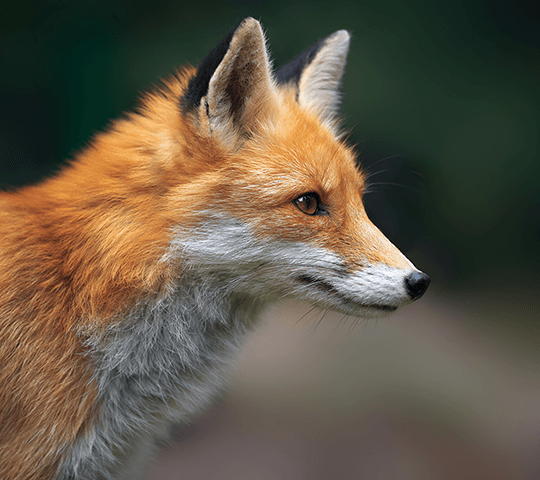In the United States, the most common species are the red fox and the gray fox. Foxes are both loved and reviled for often the same qualities. They are clever and resourceful, which merits admiration, but which also sometimes makes them pests. They are adaptable to a huge variety of habitats, including agricultural land and urban areas. They are generally smart enough to stay out of our way, but also smart enough to recognize a good deal when they see one. Living near humans, with the high availability of food, water, and shelter that they provide, is a pretty good deal.
Foxes, with their sly demeanor and bushy tails, are a familiar sight for many, yet they continue to capture the human imagination. These crafty creatures are as clever as folklore portrays, adept at navigating both the wild and suburban landscapes.
Appearance
General Characteristics
Foxes belong to the Canidae family, which also includes dogs, wolves, and other dog-like mammals. They have a pointed nose, erect triangular ears, and a long bushy tail often referred to as a "brush".
Coloration/Patterns/Distinctive Markings
Fox colors range based on the species, with the most common being the red fox, which showcases a bright reddish-brown coat. However, some foxes can be grey, silver, black, or even arctic white. The tip of their tails is usually white, while their legs and feet can often have a black tone.
Size/Features
Foxes are typically the size of a small dog. Most species weigh between 5 to 21 pounds and measure up to 41 inches long, including their tails. Their slender and agile bodies aid in their stealthy hunting techniques.
Biology
Digestion and Diet
Foxes are omnivorous, meaning their diet consists of both animals and plants. While they primarily feed on small mammals, birds, and insects, they're not averse to eating fruits, berries, and even vegetables when available.
Reproduction
Most foxes are monogamous, often staying with one partner. Vixens (female foxes) give birth once a year to a litter of 3-12 kits after a gestation period of around 53 days. The male fox, or dog, assists in rearing the young by providing food.
Unique Sensory Systems
Foxes have incredible hearing capabilities, able to detect the faintest of sounds made by prey, even beneath the snow or ground. Their keen eyesight, especially at night, is another critical tool for hunting.
Habitat
Preferred Environments
Foxes are highly adaptable creatures, comfortable in various habitats ranging from deserts, forests, and even Arctic tundras. Their dens can be found in burrows underground, among thickets, or even abandoned buildings.
Urban Encounters
As urban areas expand, foxes have become more familiar sights, even in city centers. They are skilled scavengers and can find food in human-dominated environments, rummaging through garbage or eating pet food left outside.
Temperature Regulation
Foxes adapt well to changing climates. Their coats grow thicker in colder months, providing insulation. Conversely, during warmer months, they shed, helping regulate their body temperature.
Behavior
Defensive Mechanisms
If threatened, foxes might growl, bark, or even show their teeth. They tend to avoid direct confrontations, often retreating when faced with danger.
Hunting Techniques
Using their sharp hearing and keen eyesight, foxes stalk and pounce on their prey, often surprising them from hiding spots.
Migratory Patterns
Most fox species are not migratory. However, they might travel considerable distances in search of food, especially in regions with harsher climates.
Damage/Problems
Diseases
Foxes can carry diseases like rabies and can also be hosts to various parasites, including fleas and ticks.
Burrowing
While foxes burrow primarily to create dens, this behavior can damage gardens, undermine building foundations, or disturb domestic animals.
Structural Damage
In search of food, foxes might rummage through trash, leading to littered environments. Occasionally, they may venture into houses through pet doors, causing unexpected chaos.
Trapping & Removal
Safe Handling
Foxes are wild animals and can be unpredictable when cornered. It's always recommended to approach them with caution and use protective gear.
Relocation
Captured foxes should be relocated to suitable habitats away from human-dominated areas, ensuring their safety and reducing chances of future conflicts.
Deterrence or Prevention
Property Maintenance
Ensuring your property is free from food waste and potential den sites like piles of wood can deter foxes from setting up residence.
Physical Barriers
Fences and secured garbage containers can help keep foxes at bay.
Exclusion
Consider installing mesh or barriers in areas where foxes might access buildings or gardens. Always ensure that the exclusion method does not trap any animals inside.
For all your fox-related issues, trust AAAC Wildlife Removal to handle them with care and professionalism. Our experts are trained in the humane removal and relocation of these beautiful creatures, ensuring peace of mind for both the homeowners and the foxes.



















































